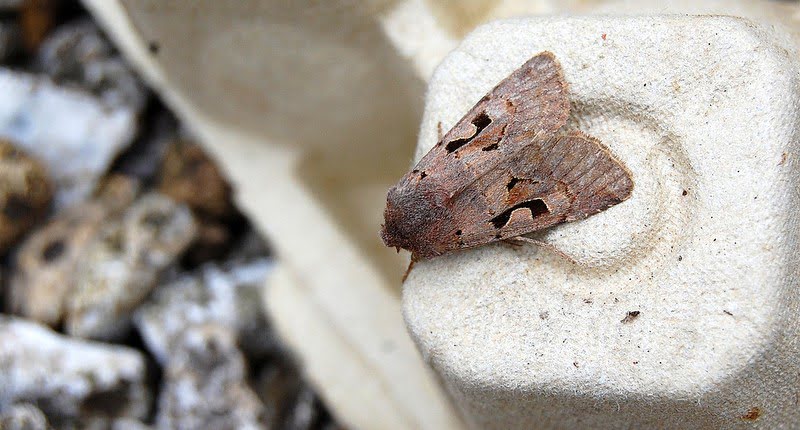Regular contributor Albert Nolan introduces some school children to the wonderful world of Irish moths, and explores some of the other wildlife that makes the most of his mothing endeavours.

I clasped my hands awkwardly while the students recited their morning prayers. As the words echoed around the classroom I wondered if the mysteries of religion were on a par with moths in the minds of the kids.
Today I was in my local school in Rearcoss village and the Junior/Senior classes were preparing to come to my garden to look at moths. I had run the trap the previous night and had hardly slept a wink fretting over would any moths appear. By three in the morning I was imagining gale force winds and rain but thankfully the Hebrew characters were out in force and the kids would not be disappointed.
A “Say hello to the moth man” brought me back to reality and after a few minuets introduction we were ready to leave. Children have a natural affinity and curiosity about the natural world and ask the most interesting questions. This makes them a highly enjoyable group top work with but also quite challenging. All of the kids had practically no positive engagement with moths. Except when one wandered into their house and a parent ran around screaming till the unfortunate thing was either crushed or released out a window. Some of them had inherited this unnatural fear and were quite nervous so I was trying to present moths in a very positive light.
On the short walk down the kids were chattering about Easter, only a few weeks away in the mind of a child and how many eggs they were going to get. When we reached the garden they gathered around the trap and we started to check the egg cartons for moths. The first Hebrew character we found drew gasps of excitement and fear and they were passed around to be examined. Some of the kids were very brave and placed them on their hands. We looked at the lovely markings on its wings and the kids were amazed that moths could be so colorful. Now that I had their attention we talked about how moths are an important source off food for bats and how their caterpillars are eaten by many species of birds.
Just as I thought to myself that this is going quite well one of the kids let out a scream and started to dance around. In between shouts of “get it out” we figured out that a moth had dropped onto his shoe and quite naturally had gone for the darkest spot which unfortunately was up the leg of his pants. Myself and his teacher exchanged glances and we had no intention of searching for the missing moth. I gently explained that when he got home and undressed it would fly out. Moths get transported to new locations in deferent ways but this must surely be one of the strangest methods.
The rest of the kids thought that this was a great game and soon they were all running around screaming. I quibbled to the teacher that the moment for education had passed but she laughed and said they were having a great time. After a few minuets things settled down and we released the surviving moths safely in the long grass. Next we sowed up a pot with wildflowers for each of the kids so that they could attract moths into there gardens. Before we left I asked the kids to look in the moth trap for a very special surprise. As we lifted out the last egg cartoon we found loads of mini chocolate eggs. I told the kids that at this time of year a very special moth comes and leaves chocolate eggs for boys and girls. I don’t think they believed me but they were glad of the sweets and it might leave a positive impression.
The workshop ended without any more dramas but I was left feeling uncertain as to how the kids had found their first introduction to the world of moths. A few days later I was at the school and some of the students gathered around and told me all about the moths they had seen at night at lighted windows and in their gardens. This gave me renewed hope that a new generation will grow up with a deeper appreciation and understanding of moths. Also having come to moths in my late twenties and struggled along without guide or reference I was hoping to make their learning about moths an easier experience.
The following weekend I was at my friend’s house where we are doing the Garden moth scheme. Taking part in this project can be a leap into the unknown as you never know what will appear in the trap. Allthough the number of moths caught during the winter could be counted on one hand I think that we appreciated them even more due to their scarcity. Now that Spring is here and the weather is thankfully warmer, the memories of the cold dark mornings have faded. While the moths have been amazing from our first Streamer to the jangling flight of the Popular hawk moth what fascinates us is the wildlife that is often associated with and benefits from trapping moths.
When I arrived Dan was crouched down and looking intently at the ground near the moth trap. After I parked the car I joined in and I could see about a dozen small holes with some thing moving in them. I got a small stick and gently scrapped away a bit of soil and a black fly slowly emerged. I gently placed it in my hands cupped hands and it flew awkwardly around our heads. We later identified it as St Marks fly named after one of the four evangelists. It requirements are short grass with some bare soil and this habitat had arisen while the area was been managed for moths.
Nearer the trap where our feet had exposed a bare patch of soil there were little holes with a tiny mound of excavated soil. After a little bit of investigation we found out that these were created by a burrowing bee that need exposed soil. In the wild animals would fulfill this role while looking for food but I suppose from the bees’ point of view there is no difference between the feet of people and the hooves of animals.
Because this is a weekly survey and we are trapping in the same location each week other species of wildlife have started to take advantage of this natural bounty. Frequently we find the wings of moths scattered around the trap where birds or bats have had an easy meal. The number of wings we find is quite small so I don’t think this will have any affect on their long term population. This was very evident one morning as I watched a Pair of Great tits hunting around the trap. I has been out earlier and removed all the moths from the outside of the trap and in the surrounding grass. They landed first on top of the trap and peeked into every corner searching for insects. When they found one they flew back to their nest in a nearby tree. Several attempts were made to get at the moths in the trap but they could find no way in. After that they landed in the grass and slowly worked their way around picking up insects for their chicks. They made about twenty trips before finally moving on.
Spiders too have taken up residence in our trap to feast upon all the flies that are attracted to the light. This indirect connection between moth trapping and the benefits for other wildlife species is not very well explored but would make a fascinating study. Like the moths in our gardens we have only scratched at the surface of the night in our understanding of their complex lives.
The long week has ended and the evening grass feels cool between my toes. A Blackbird sings lazily from the trees while I finish setting up the trap. With a flick of the switch the light hisses reassuringly and the garden starts to brighten up. Tomorrow will bring fresh discoveries and mysteries in this interesting journey with moths.
A special thanks to Dan for his dedication and patience in running the moth trap each week at his house.
Photo Credit: ![]() Some rights reserved by nicolerugman via Flickr
Some rights reserved by nicolerugman via Flickr









